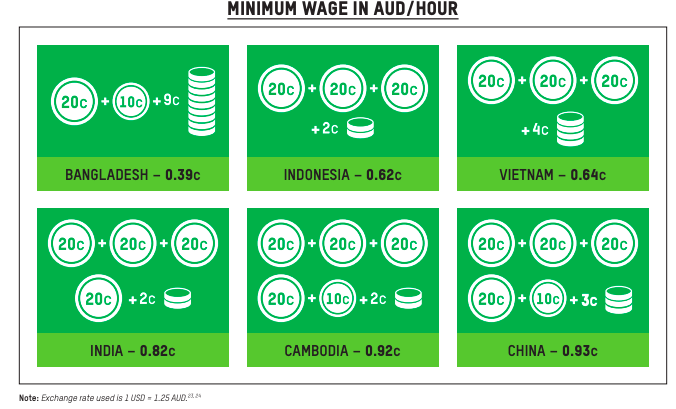When considering sustainability in the supply chain, the first concepts that typically come to mind are solutions like green warehouse space or fuel-efficient trucks.
Sustainability in the supply chain extends much further than that. In retail, for instance, the clothing and fashion industry have the opportunity to progress through building a more sustainable approach.
The current clothing retail climate is somewhat dominated by fast fashion, a practice of mass-producing clothing items cheaply, so they can be sold in the most cost-effective way possible.
To make their products this inexpensive, companies typically must hire underpaid workers and forego using clean, innovative materials.
Given the current state of the industry and the rise of fast fashion, sustainability will be key to sparking change within the fashion industry in upcoming years.
This article will detail three major benefits of moving away from fast fashion in 2020.
Sustainable Fashion Improves Environmental Health and Working Conditions
Sustainable fashion has the potential to have very positive impacts on the planet, both in terms of cultivating greener production practices and introducing labor equality to your procurement processes.
For instance, it may be cheaper to use polyester to create clothing. Customers are also used to purchasing goods made using that material. However, because polyester isn’t made like cotton or hemp, synthetic materials aren’t as good for the planet as other textile options.
According to Forbes, polyester clothing items can take up to 200 years to decompose. Your company will be contributing to the betterment of the environment by searching out more innovative, natural fabric options.
Currently, the fashion industry accounts for a total of 8% of all greenhouse gasses emitted into the atmosphere.
Ridding your production practices of synthetic materials won’t necessarily help mitigate climate change on its own. It’s recommended that supply chain leaders discover methods of incorporating renewable energy into production mills. This innovation will have a direct effect on carbon emissions.
As of now, according to Stand, Earth’s fashion climate scorecard, very few companies are in the green on climate change mitigation.

Source: Stand.Earth
Levi’s is one of the few companies that has been successful in cutting their supply chain off of fossil fuels while others are failing to do the same. This includes about 70 members of the Sustainable Apparel Coalition.
Adopting sustainable practices also contributes to labor fairness, safety and equality. Fast fashion has contributed to increases in child labor, slavery and deaths resulting from working conditions.
Oxfam found that most companies could easily afford to absorb the cost of providing living wages to all workers operating within their supply chain, but many fail to do so.

Source: Oxfam
By simply tracking all of your workers’ wages throughout the supply chain, you can significantly contribute to the overall health and sustainability of your supply chain.
Common practices within the contemporary fashion supply chain industry cause harm to both the environment and workers involved in the production process. Your company can take steps to change that through sustainable fashion.
Sustainability Encourages Innovation in Your Field
The fashion industry is responsible for the second-highest amount of pollution in the world, and that can’t be changed without innovating on current practices.
Business owners around the world have already recognized this and started developing new technologies to address the pressing challenges threatening the planet.
In her interview with Forbes, Megan Eddings discusses her proprietary sustainable textile that she developed through her company Accel Lifestyle. She indicates that innovative textiles can help move supply chains away from harmful synthetic materials.
“Microplastics are a huge concern for not only the environment but also our health,” she said. “Sustainable fashion takes into account the entire supply chain and life cycle of a garment, from where and how it is made to when it ends up in our landfills.”
Edding’s second point is vital to consider. While she’s focusing on promoting renewable materials, there are several other links in the supply chain that determine how sustainable the operation is as a whole.
In short, an entire supply chain can’t rely on renewable resources alone to carry your business toward sustainability. You have to innovate and boost efficiency across your business as a whole to make a change.
Technology can assist you in making sure that you’re operating your business as efficiently as possible. It also helps you keep track of your inventory, worker payroll and shipments. Leverage these technologies to spot weak points in your efforts to become more sustainable. From there, you’ll be better equipped to run a leaner, greener sustainable company.
Catalyzing change requires thinking outside of the box. Determine your path to innovating your processes for sustainability by effectively utilizing supply chain management technologies.
That way, you’ll have no trouble linking isolated, sustainable bright spots together and constructing a greener supply chain.
Your Sustainable Approach Will Appeal to Consumers
Consumers are aware of the negative ramifications of fast fashion and the moral dilemma involved in purchasing goods produced utilizing those processes.
Because of this wide-spread awareness, it’s in the best interest of companies everywhere to adopt sustainable practices to appeal to your audience. According to research on customers in the US and United Kingdom, over half (52%) of consumers want the industry to become more sustainable in the near future.
While consumers understand that this may cost more money, making the items less appealing for purchase, they’re also voicing recommendations to companies, detailing how they’d like to see them address sustainability. Those in favor of more sustainable options requested that supply chain companies do the following:
- Label sustainably-made clothes
- Offer discounts on sustainable clothing
- Allow customers to trade in second-hand clothing for store credit
- Make sustainably-made clothes the default search results in online stores
- Advertise sustainable products outside of your online store
Companies that adopt these practices show that they care about promoting products that are best for the world around them. This, in turn, will turn consumers into loyal customers.
Showcase your supply chain’s bright spots by promoting them to your customers. They want to see your business go green, so keep them updated on your progress toward that goal.
Work Sustainability into the Entire Supply Chain
It isn’t enough to take one single sustainable practice that only affects one link of the supply chain.
Because of the inherently interconnected network that the supply chain has become, all operations affect each other. It’s essential to take measures to incorporate sustainability into all aspects of your business.
You can do this by focusing on innovation and optimizing your internal technological solutions. That will assist you in helping the planet, both from an environmental and labor-focused perspective.
Lastly, your customers want you to be sustainable. Listen to their feedback to include them in your journey to a greener future.









